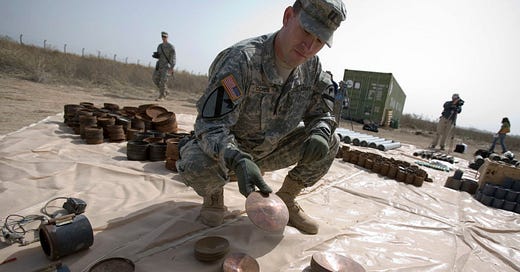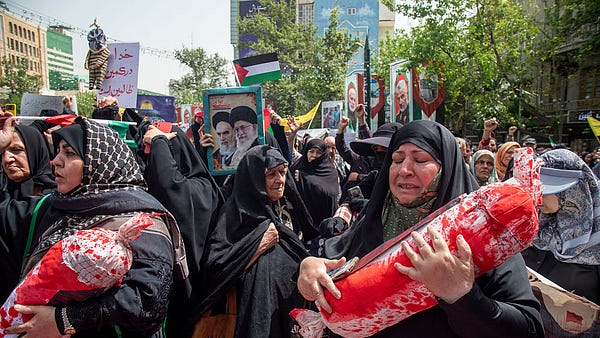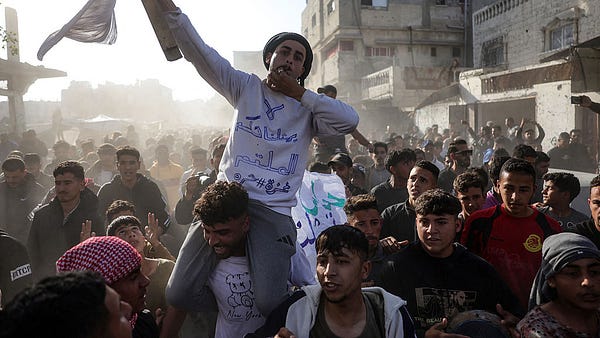
The Free Press

The war that began on October 7 when Hamas invaded Israel has been almost universally described in the press as another bloody chapter in the Israel-Palestinian conflict. But that’s only half-true. Or rather, it is only one front of a much broader war—a war that pits Iran and its proxies against America and its allies. And a war that has already cost American lives.
Consider the following events that have taken place since October 7:
On January 11, two Navy SEALs were on a night mission to intercept an Iranian shipment destined for Houthi rebels in Yemen. In a raid of a small boat known as a dhow, one SEAL fell into rough waters off the coast of Somalia and another dove into the Gulf of Aden in an attempt to rescue him. On Sunday, U.S. Central Command announced that the SEALs were presumed dead. Despite the casualties, the mission was a success. U.S. officials have told news outlets that the SEALs found missile components on the ship that matched the projectiles used by the Houthis in attacks on commercial shipping in the Red Sea.
On January 15, Iran’s Revolutionary Guard claimed credit for a missile and drone attack in Erbil—the capital of Iraq’s Kurdish region, home to America’s historic allies. The Iranian regime claimed the strike hit an Israeli Mossad base in response to an Israeli strike in Syria that killed one of its commanders. But Kurdish news agencies have since reported that the target was the personal home of prominent builder and businessman Peshraw Majid Agha Dizeyi, who was killed along with several of his family members including his 11-month-old daughter. The attack was the first direct Iranian strike in the region since October 7.
At approximately 6:30 p.m. (Baghdad time) on January 20, multiple ballistic missiles and rockets were launched by Iranian-backed militants in Western Iraq targeting al-Asad Airbase. Most of the missiles were intercepted by the base’s air defense systems while others hit the base. Damage assessments are ongoing. Two U.S. personnel suffered traumatic brain injuries but are now back on duty. At least one Iraqi service member was wounded.
As those rockets were being launched, Chief Warrant Officer Garrett Illerbrunn was recovering at a hospital in Washington, D.C., from a brain injury he suffered on Christmas Day after shrapnel lodged in his skull following a drone attack on a U.S. base in the Kurdish city of Erbil. (Illerbrunn has since emerged from his coma and has begun to move his face and limbs, according to a CaringBridge journal set up by his loved ones.) The drone attack that nearly killed Illerbrunn was launched by the Iranian-backed militia Kataib Hezbollah.
In response to the January 20 missile attacks on al-Asad Airbase, the U.S. launched a round of air strikes on January 23 that targeted Kataib Hezbollah. According to a statement from U.S. Central Command, the air strikes hit the group’s “headquarters, storage, and training locations for rocket, missile, and one-way attack UAV capabilities.”
According to the Washington Institute for Near East Policy, there have been more than 100 drone attacks and nearly 50 rocket attacks against U.S. positions in Iraq and Syria since October 18. By comparison, there was only one such drone attack and one rocket attack from these militias between October 2022 and October 2023. Almost all of the recent attacks have been initiated by the Iraqi militias the government in Baghdad has tried to tame. In Yemen, the Iranian-supported Houthi rebels have menaced U.S. ships in the Red Sea, launching drones, rockets, and missiles at vessels while claiming to enforce an embargo of Israel.
Since November 18, Iranian-backed Houthi rebels have launched at least 25 attacks on shipping vessels in the Red Sea. The head of the Navy’s Fifth Fleet, Vice Admiral Brad Cooper, said of the attacks: “Clearly, the Houthi actions, probably in terms of their attacks on merchant shipping, are the most significant that we’ve seen in two generations.”
Most Americans vaguely know that there is trouble in the Middle East, but they likely do not know all of these details and surely do not know the names Christopher Chambers and Nathan Gage Ingram—the two Navy SEALs who perished this month in the Indian Ocean defending the freedom of maritime navigation in the region.
That’s because these stories have barely been covered and the Biden administration has sought to downplay these incidents and lower tensions with Iran, fearing the prospect of a regional war.
But some Americans know well the cost of Iran’s ongoing aggression against America. Just ask the Farr family of California.
On February 26, 2006, U.S. Army Specialist Clay Farr encountered a roadside bomb in Iraq. The right side of his body was shredded with shrapnel, his right hand was severed from his arm, and the top of his head was blown off. He died four hours later in a military hospital.

His father, Patrick Farr, told The Free Press last week that his wounds were so egregious, the casualty officer asked him how he felt about cremation. Farr opted to bury his son in a cherrywood coffin with a white shroud covering his mutilated remains.
Farr was killed by an Iranian weapon known as an explosively formed penetrator, or EFP.
According to the Pentagon, Farr is one of 603 American service members Iran was responsible for killing during the Iraq War, largely through providing its militias with these deadly bombs capable of melting the armor of Humvees.
Some of the families killed and maimed by Iranian weapons and militias in the last twenty years are dumbfounded by the response from the Biden administration to Iran’s escalations since October 7. One of them is Clay Farr’s father, Patrick.
Farr said in an interview that he did not want to send more U.S. troops to the Middle East. But he added that Biden’s approach to Iran “keeps letting them build back their forces.” He added that Biden’s mistake when he came into office was trying to reenter the Iran nuclear deal. “That is encouraging Iran to keep doing business as usual and keep killing Americans,” he said. “Then he wants to supply Iran with money. What do you think Iran is going to do with that money? Fund Hamas and fund Hezbollah.”
Tricia English, who lost her husband Shawn, an Army captain, in 2006 to an Iranian EFP, told The Free Press she has been disgusted in recent months as she watched Iran’s proxies attack U.S. forces. “We are funding our enemy and sending the service members to be their victims,” she said. English was frustrated that the Iran sanctions that remain on the books have been ignored by the Treasury Department. “We are not enforcing any sanctions,” she said. “We are letting people do business with people with whom we have sanctions against. We are ignoring the problem.”
English and Farr have a point. Under former president Donald Trump’s administration, Iran exported on average 775,000 barrels of oil per day. Under Biden, that figure has nearly doubled to 1.4 million barrels per day, according to the Foundation for Defense of Democracies. This added revenue has not only stabilized Iran’s economy—it has freed up millions of dollars for the proxies now waging war on American forces in the Middle East.
It’s almost like there are two policies for the Biden administration. In Washington, the State Department and Treasury Department are still pursuing a nuclear deal with Iran. In Iraq, Syria, and Yemen, the U.S. military is at war.
This approach to Iran’s proxies is most striking in the U.S. response to the Houthi militias in Yemen. American and British war ships in the Red Sea have been barraging Houthi positions in Yemen this month. And yet, in Washington, the Biden administration has been cautious about applying economic pressure.

Last week, the White House reversed its 2021 decision to remove sanctions on the Houthis, designating the group under the less stringent list of Specially Designated Global Terrorist organizations. But Richard Goldberg, a senior adviser at the Foundation for Defense of Democracies and a former National Security Council staffer under former president Donald Trump, noted that the designation also included further exemptions to the sanctions, ostensibly to allow humanitarian aid to flow to Yemen. “They get the good headline,” he told me of the Biden administration, “while doing nothing to provide any economic isolation or pressure.”
Joel Rayburn, a former special envoy for Syria, told me he suspects Biden’s reluctance to enforce sanctions against Iran and its proxies is because “senior levels of the administration are staffed by Iran negotiators from 2015, [and] they still prioritize keeping the door open for another JCPOA [Iran nuclear deal] once the high-intensity phase in the war in Gaza has passed.”
As the Middle East grapples with the contradictions of Biden’s broader policy since October 7, some of the victims of Iran’s aggression are seeking reparations. In 2021, English and Farr were among more than 300 plaintiffs to win a summary judgment in the U.S. district court for the District of Columbia that Iran was responsible for the deaths and injuries of their loved ones. That court is now deciding how much money the plaintiffs will receive from a fund created in 2015 to compensate victims of state sponsors of terrorism like Iran.
English said she was frustrated that the court has taken so long to finally consider the damages owed to her and other families. She is more frustrated, though, that America has yet to fully respond to Iran’s war.
“If someone is murdering 603 of our citizens, isn’t that an act of war?” she asked. “What have we done about it?”
Eli Lake is a Free Press columnist and host of The Re-Education podcast. Follow him on X (formerly Twitter) @EliLake. Read his last Free Press piece, “How Texas A&M’s Deal with Qatar ‘Puts American Security at Risk.’ ”
And to support more of our work, become a Free Press subscriber today:















So is China. So is Russia. So is North Korea. We just ignore it.
This makes me physically ill. I can't believe this isn't a bigger topic of discussion in an election year. That this administration wants to "keep the door open" for another JCPOA is completely insane where the line from the JCPOA to 10/7 is bright red and still dripping with blood. It obviously has actual real-world consequences for our country and our military as well. Biden "escalated" a long time ago when he agreed to negotiate with Iran, he doesn't get to unring that bell now.